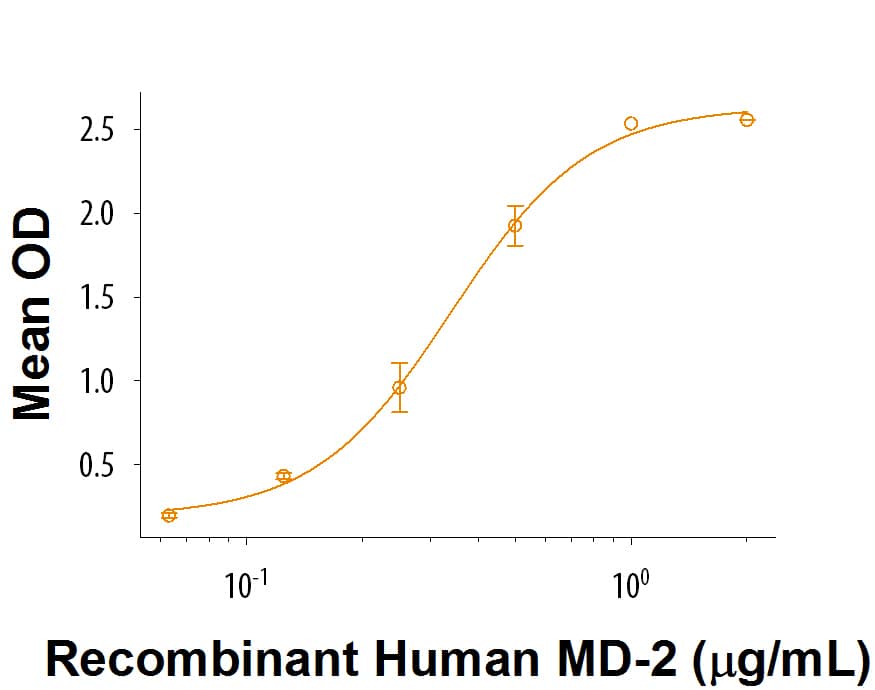Recombinant Mouse TLR4 Fc Chimera Protein, CF
R&D Systems, part of Bio-Techne | Catalog # 9149-TR

Key Product Details
Source
CHO
Accession #
Structure / Form
Disulfide-linked homodimer
Conjugate
Unconjugated
Applications
Bioactivity
Product Specifications
Source
Chinese Hamster Ovary cell line, CHO-derived mouse TLR4 protein
| Mouse TLR4 (Asn26-Lys629) Accession # Q9QUK6 |
DIEGRMDP | Mouse IgG2a (Glu98-Lys330) |
| N-terminus | C-terminus |
Purity
>90%, by SDS-PAGE visualized with Silver Staining and quantitative densitometry by Coomassie® Blue Staining.
Endotoxin Level
<0.10 EU per 1 μg of the protein by the LAL method.
N-terminal Sequence Analysis
Asn26
Predicted Molecular Mass
96 kDa
SDS-PAGE
115-137 kDa, reducing conditions
Activity
Measured by its binding ability in a functional ELISA.
When Recombinant Mouse TLR4 Fc Chimera is immobilized at 2 μg/mL, 100 μL/well, the concentration of Recombinant Human MD-2 (Catalog # 1787-MD) that produces 50% of the optimal binding response is approximately 0.15-0.9 μg/mL
When Recombinant Mouse TLR4 Fc Chimera is immobilized at 2 μg/mL, 100 μL/well, the concentration of Recombinant Human MD-2 (Catalog # 1787-MD) that produces 50% of the optimal binding response is approximately 0.15-0.9 μg/mL
Scientific Data Images for Recombinant Mouse TLR4 Fc Chimera Protein, CF
Recombinant Mouse TLR4 Fc Chimera Protein Bioactivity
When Recombinant Mouse TLR4 Fc Chimera (Catalog # 9149-TR) is coated at 2 µg/mL (100 µL/well), Recombinant Human MD-2 (Catalog # 1787-MD) binds with a typical ED50 of 0.15-0.9 µg/mL.Formulation, Preparation and Storage
9149-TR
| Formulation | Lyophilized from a 0.2 μm filtered solution in PBS. |
| Reconstitution |
Reconstitute at 500 μg/mL in PBS.
|
| Shipping | The product is shipped with polar packs. Upon receipt, store it immediately at the temperature recommended below. |
| Stability & Storage | Use a manual defrost freezer and avoid repeated freeze-thaw cycles.
|
Background: TLR4
MD‑2/LPS with TLR4 induces receptor oligomerization and the triggering of an inflammatory response (2, 14). Increased levels of plasma MD‑2 in septic shock patients sensitizes MD‑2 non-expressing epithelial cells to LPS and promotes widespread tissue inflammation (15).
References
- Mukherjee, S. et al. (2016) Braz. J. Infect. Dis. 20:193.
- Plociennikowska, A. et al. (2015) Cell. Mol. Life Sci. 72:557.
- Erridge, C. (2010) J. Leukoc. Biol. 87:989.
- Medzhitov, R. et al. (1997) Nature 388:394.
- Poltorak, A. et al. (1998) Science 282:2085.
- Qureshi, S.T. et al. (1999) J. Exp. Med. 189:615.
- Shimazu, R. et al. (1999) J. Exp. Med. 189:1777.
- Visintin, A. et al. (2001) Proc. Natl. Acad. Sci. USA 98:12156.
- Akashi, S. et al. (2000) J. Immunol. 164:3471.
- Nagai, Y. et al. (2002) Nat. Immunol. 3:667.
- Re, F. and J.L. Strominger (2003) J. Immunol. 171:5272.
- Kennedy, M.N. et al. (2004) J. Biol. Chem. 279:34698.
- Gioannini, T.L. et al. (2004) Proc. Natl. Acad. Sci. USA 101:4186.
- Saitoh, S. et al. (2004) J. Endotoxin Res. 10:257.
- Pugin, J. et al. (2004) Blood 104:4071.
Long Name
Toll-like Receptor 4
Alternate Names
CD284
Gene Symbol
TLR4
UniProt
Additional TLR4 Products
Product Documents for Recombinant Mouse TLR4 Fc Chimera Protein, CF
Product Specific Notices for Recombinant Mouse TLR4 Fc Chimera Protein, CF
For research use only
